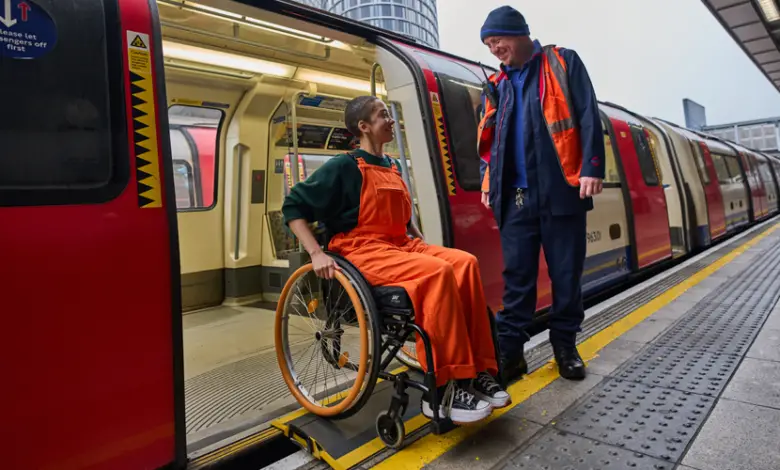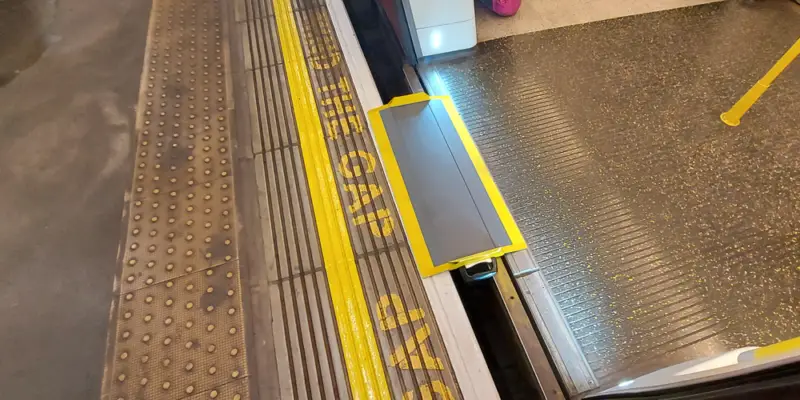
Plans for increasing accessibility at London Tube stations as bridging device trial launches
Transport for London (TfL) has published the results of its step-free access consultation, which many of you took part in, as it launches a trial of a new bridging device as part of its ongoing work to make the capital’s network more accessible and inclusive.
Bridging device trial on London Underground
Our specially commissioned bridging device has been designed to provide additional support, comfort and reassurance to customers at step-free stations where there remains a small gap between the platform and train carriage.
The bridging device (see image below) is the same width as the boarding ramps already in extensive use across the network but is only 200mm in length.
We are inviting customers to try the new bridging device at eight Jubilee line stations until February 2023 – including London Bridge, Canary Wharf and Green Park.
You can just turn up at any one of the stations in the trial to request to use the bridging device and station staff will be able to deploy it.
They are also available to assist anyone wanting to get off the train at one of the trial stations, by requesting for a member of staff to be waiting with the device.
Customers who have used the device are invited to provide comments about their experience, including suggesting a name for it.
If the trial is successful, we will consider extending the use of the bridging device across the London Underground and wider TfL network as we continue working to make the capital’s network more accessible and inclusive.
Find out more about assistance on London’s Tube network and leave your feedback for the bridging unit.
London Underground step-free access findings
From November 2021, we ran a 14-week public consultation looking into how it could best shape the future of step-free access on the Tube when suitable funding is identified.
More than 5,500 people, including Disability Horizons readers, took part in the public consultation. We found that…
- 66% of public respondents would use the Tube more if there were more step-free stations.
- 880 people who completed the consultation said they do not currently use the Tube, but 80% of these said they would use it if it was more accessible to them.
- Stations that interchange with other transport services were a clear priority for respondents, along with stations that are within easy reach of hospitals and healthcare services.
- 69% of public respondents felt that it would be best to prioritise step-free access at a combination of some smaller and medium-sized Tube stations and part of a complex station (as opposed to just one complex station – a few medium stations or more smaller stations).
- 63% of respondents preferred us to ‘plug the gaps where there is a large area with few step-free stations rather than create ‘hubs’ by filling in the gaps where most of an area is already step-free.
- More than half said their usage of the Tube would expand (52%) and that their journeys would be made easier (68%) and less stressful (64%) if their most important Tube stations were made step-free.
Mark Evers, our Chief Customer Officer, said: “Making our transport network more accessible and inclusive is a top priority for us, as we know that a more accessible public transport network benefits everyone.
The response to the consultation shows how important accessibility is for encouraging more people to use public transport.”
Mark added: “The bridging device has been designed to improve customers’ confidence and experience of using the network and I hope as many people as possible try it out during the trial period.
The results of the step-free access consultation have already been embedded in our short-term work to improve accessibility and will continue to shape our future goals.”
Seb Dance, Deputy Mayor for Transport said: “We are working hard to improve step-free accessibility across the TfL network in order to build a better, fairer London for everyone.
This new trial is one example of how we are seeking out innovative solutions to enhance step-free access.
It is also vital that our accessibility plans are informed by disabled and older customers and I am delighted that we have had such a great response to the consultation.
There is still work to do and we will ensure that this feedback shapes how we prioritise and deliver step-free stations into the future.”

Accessibility of the TfL network
There are now more than 200 step-free stations across the TfL network. These include 92 Tube stations, 62 London Overground stations, all DLR stations and Tram stops.
All 41 Elizabeth line stations have step-free access, with the majority of central stations being step-free from street to train. You can use this map to see all of the stations that are already step-free.
But we want to do more. We are delivering step-free improvements across the whole transport network as part of our commitment to increasing accessibility and inclusion.
We are currently working with third parties to deliver step-free access at Knightsbridge and Paddington (Bakerloo line only).
The ongoing station upgrade works at Bank will also deliver step-free access to the Northern line and improved step-free access to the DLR as well as a new accessible toilet in the ticket hall.
The current proposed designs for the redeveloped Euston station – which are being designed, funded and delivered as part of High Speed 2 – would also provide step-free improvements to Euston and Euston Square Tube and rail stations.
The consultation results also outlined other aspects of the network that customers believe could be improved including toilet provision, accessible signage, staff boarding ramp training and walking distances between step-free routes. We have been working to address these by:
- Assigning a budget to improve toilets that are most in need of repair. An analysis is also being undertaken to assess where there are gaps in accessible toilet provision, especially at stations with existing step-free access
- Provided accessible signage to improve step-free wayfinding in stations, which have been installed at 16 London Underground, 11 Elizabeth line and two Docklands Light Railway (DLR) stations, with more to follow shortly
- Staff at stations where boarding ramps are available have had additional briefings to ensure they can assist customers requiring ramp assistance. We continue to provide station staff with essential accessibility training, with a view to refreshing existing training materials
- We are adding interchange walking time to our online Journey Planner. This displays as a stage on the journey, for example ‘interchange from Victoria to Central line – 5 minutes’
Our funding situation as a result of the pandemic has affected the progress of step-free projects. However, we will use the results from the consultation to help us understand which stations would be good candidates for future step-free access work.
External funding will be critical to the ongoing delivery of more step-free schemes due to the financial pressures that we continue to face. We will continue to work with third parties and developers to identify funding.
In September, we submitted a list of 20 stations for consideration for the Department for Transport’s Access for All programme, which provides funding to make stations more accessible.
We will also look to support the delivery of step-free improvements, where possible, as part of our wider commercial development programme at stations and our planned property developments across London.
By Transport for London
More on Disability Horizons…
- Have your say on a possible new cross-river bus network in East London
- Have your say on London taxi fares potentially increasing
- Samantha Renke: why I love London’s South Bank for accessibility
- Check out our range of wheelchair bag lap trays on the Disability